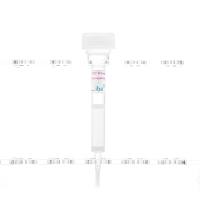Capillary electrophoresis (CE) is an efficient and fast microseparation technique that is well suited for the separation of
nucleic acids. CE is routinely used for the separation of double-stranded DNA fragments; single-stranded DNA fragments and
polymerase chain reaction (PCR) products in our laboratory. CE is a versatile tool for separating nucleic acids in molecular
biology (1
). CE has the advantages of automation, small sample requirement, fast and efficient separation, real-time detection, and
negligible buffer waste in comparison to slab-gel electrophoresis. However, the major drawback of CE is low amount of sample
throughput because samples are analyzed sequentially. This problem is resolved by using a capillary array electrophoresis
(CAE) (2
,(3
). Since conventional CE systems are equipped with a single capillary, a practical way to increase throughput is to minimize
the analysis time per sample. This has been accomplished by using a range of an effective length capillary as short as 7 cm
and field strength as high as 2000 V/cm for the separations of small ions, drugs, and proteins (4
-7
).






